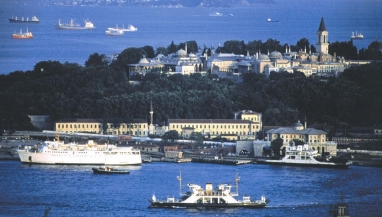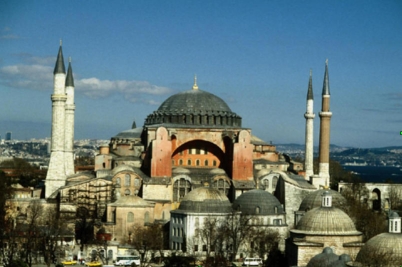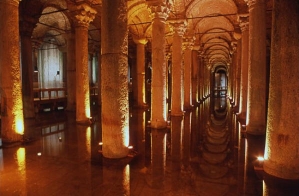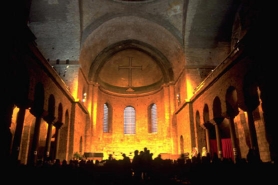About İstanbul
|
İstanbul, once known as the capital of capital cities, has many unique features. It is the only city in the world to straddle two continents, and the only one to have been a capital during two consecutive empires - Christian and Islamic. Once was capital of the Ottoman Empire, İstanbul still remains the commercial, historical and cultural pulse of Turkey, and its beauty lies in its ability to embrace its contradictions. Ancient and modern, religious and secular, Asia and Europe, mystical and earthly all co-exist here.
Its variety is one of İstanbuls greatest attractions: The ancient mosques, palaces, museums and bazaars reflect its diverse history. The thriving shopping area of Taksim buzzes with life and entertainment. And the serene beauty of the İstanbul strait, Princes Islands and parks bring a touch of peace to the otherwise chaotic metropolis.
PLACES OF INTEREST
Topkapı Palace
Overlooking the Golden Horn stands the mare of buildings that was the great palace of the Ottoman Sultans from the 15th to the 19th century. Today it is one of the richest museums of the world.
Topkapı was not just the private residence of the Sultan and his court. As home of Divan, it was the meeting place of the supreme executives and the judicial control of a great empire as well. It is now housing the most astonishing collection of rare objects that once belonged to the sultans.
Dolmabahçe Palace
The 19th century residence of the Ottoman sultans and the place where the founder of Modern Turkey, Atatürk died in 1938, the Dolmabahçe Palace beautifully situated with a 600 m. frontage on the Bosphorus. It boasts an impressive ballroom and ornate Victorian furniture.
Beylerbeyi Palace
This palace was constructed in the same style as Dolmabahçe Palace. It is situated on the Asiatic Shore of the Bosphorus and was built during the reign of Sultan Abdülaziz in the year 1865. The palace consists of the 24 rooms and 6 walls. Italian, French and Turkish artists created the ceiling decorations. The palace was used as the summer palace of the sultans.
Sultan Ahmed Mosque (The Blue Mosque)
It is known as the Blue Mosque because of its magnificent interior decoration with the İznik tiles with their dominating blue color. The Blue Mosque stands firmly opposite of Hagia Sophia.
Blue Mosque is the supremely elegant imperial mosque of Sultan Ahmed I with its 6 minarets. It was built by the architect Mehmed Aga.
Hagia Sophia
Hagia Sophia is one of the worlds most important buildings from the architectural point of view. The ancient basilica was built by Constantine the Great. The first church was destroyed by a fire. A new church was built at the same place by Theodosius II, but this was also burned down. It was then re-constructed by Justinian in the 6th century. The construction of Hagia Sophia witnessed sixteen hundred years of the history.
Hippodrome
The vast area covered by the Hippodrome lies between the Hagia Sophia Museum and the Blue Mosque.
During the Byzantine area, Hippodrome was the center of civil activities; not only chariot races but also celebrations in honor of the emperor also took place here.
Süleymaniye Mosque
The mosque of Sultan Süleyman the Magnificent, where he and his wife are also buried, is considered to be the most beautiful and splendid of all the imperial mosques in İstanbul. It was built in among 1550 and 1556 by the famous architect Sinan, whose dearest wish was to surpass the builders of Hagia Sophia.
Archeological Museum
This extraordinary museum was established in the reign of Sultan Abdülhamit II, by Osman Hamdi Bey who was also a painter and a collector. It now houses the best antique in the world. The antiquities mostly originate from Anatolia, the Middle East and North Africa that were all was the part of the Ottoman Empire.
İbrahim Pasa Palace (Turkish And Islamic Arts Museum)
The palace of Ibrahim Pasa (1524) is on the western side of the Hippodrome, now housing the Turkish & Islamic Arts Museum, gives a glimpse into the opulent life of the Ottoman upper class in the time of Süleyman the Magnificent.
Underground Cistern
This cistern is the grandest and most impressive of its kind. The giant reservoir was built in the 6th century. The water that came from the Belgrade Forest that is 19 km away used as the water supply of the palaces. It is 140 m.s long and 70 m.s wide. It has 336 columns supporting the brick dome, which are arranged as 12 rows of 28 columns in each and are topped by Byzantine Corinthian Capitals. The Cistern was recently renovated in 1987.
Grand Covered Bazaar
In 1461, Sultan Mehmed II built the first bazaar and used wood as the material, which is now called as Eski Bedesten. It is oldest section of the bazaar. After several fires the bazaar was reconstructed in 1894. Today the buildings are surrounded by a wall occupying an area of 200.000 sq. m. Approximately 5.000 shops are spread out in a giant labyrinth of small streets and passages, which are mostly arranged according to their trades; antiques, gold, silver leather etc.
Egyptian Bazaar Spice Market
This was built by Hatice Sultan with the taxes collected from Cairo for the trade of Egyptian commodities, especially herbs and spices. The bazaar with its domes is L shaped and belongs to the complex of the mosque of the Sultans Mother.
Golden Horn
The Golden Horn is an inlet of the sea and a natural harbor, dividing the European Side of Istanbul into two as, the Old Istanbul and the Modern İstanbul.
This arm of the Bosphorus is called Golden Horn due to its horn-like shape and the golden color of the water surface at sunset.
Pierre Loti Cafe
Having a magnificent view of the Golden Horn, the cafe is located high above a hill. It has been called by the name of a French author Pierre Loti. Pierre Loti, (1850-1923) was one of the few writers who came into prominence and enjoyed and outstanding success during his lifetime. His real name was Julien Viaud and as a naval officer he had opportunity of visiting many foreign countries. Turkey seems to have had a very special attraction for him. During his visits to Turkey, Loti dressed and acted like a Turk, with a fez upon his head and a rosary in his hand, he roamed in the intricate streets of İstanbul, rested in coffeehouses smoking a gurgling pipe, or sipping a cup of thick Turkish coffee. He liked to stroll around the mosques of Fatih or Selim but Eyüp was his favorite place. He frequented this cafe, admiring the magnificent panorama of the Golden Horn, absorbing the quiet and peaceful atmosphere that reigned there. No one knows exactly how or where it started but the place has been called after him ever since: Pierre Loti Kahvesi.
St. Saviour In Chora (Kariye Museum)
A small Byzantine church decorated with extraordinary late14th century frescoes and mosaics portraying the life and miracles of Christ. The most important and extensive series of Byzantine paintings in the city and among the most significant in the world, a precursor of the Renaissance.
Galata Tower
The tower was built by the Gynoecias in the 14th century. The aim was to control the entrance to the Golden Horn. Now with restaurant and nightclub, this tower is one of the best spots for a beautiful snapshot of the Golden Horn and the historical peninsula.



